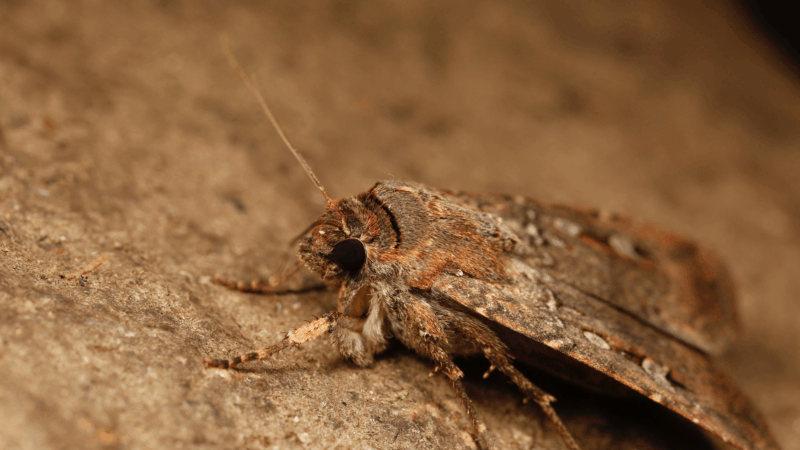How migrating Australian moths find caves hundreds of miles away
The Bogong moths of Australia aren’t much to look at, says Andrea Adden, a neurobiologist at the Francis Crick Institute. “They’re small brown moths with arrow-like markings on the wings. They’re pretty nondescript.”
But these insects undertake an epic migration twice in their lifetime, traveling hundreds of miles in each direction.
Researchers have shown that the Earth’s magnetic field helps the moths orient, but that alone wasn’t sufficient. “They needed something visual to go with it,” says Adden.
She wanted to know what that cue might be over such a vast landscape — especially at night when there’s little light.
In a paper published in the journal Nature, Adden and her colleagues show that the cue comes from the heavens. That is, the starry sky allows the Bogong moths to both orient and navigate.
“It’s the first time that we have found an invertebrate using the stars to navigate,” says Adden. “And also the first time that anyone had seen neurons that specifically respond to the starry sky in the insect brain.”
A 600-mile winged migration
Bogong moths follow an annual rhythm.
They hatch in their breeding grounds in the spring in southeast Australia where it gets really hot in the summertime. “So if they were to reproduce immediately, their larvae would starve because there is not enough food,” says Adden.
Instead, the moths migrate over multiple nights more than 600 miles south to the Australian Alps where they settle in cooler caves, entering into a dormant phase called estivation (like hibernation but in the summer), by the millions.
“It’s just moth over moth over moth,” says Adden. “You don’t see any cave wall anymore. It’s just moths.”
In the fall, they return to their breeding grounds, mate, lay their eggs, and die.
“Then the next year, the new moths hatch,” says Adden. “And they’ve never been to the mountains. They have no parents who can tell them how to get there.”
And yet they make it.
She suspected the stars might offer just the cue they need. “The Milky Way is such a stunning sight,” she says. “And it seemed an obvious thing to use if you are a moth living in that environment.”
A planetarium show in miniature
To test her theory, Adden, who was doing her Ph.D. at Lund University in Sweden at the time, and her colleagues caught moths in the Australian Alps and ran them through one of two experiments in the dead of night.
The first was a behavioral test. It involved placing a moth inside what was basically a mini-planetarium that contained a projection of the night sky and no magnetic field.
“It’s not an experiment that always works,” says Adden. “We’re reliant on the moths cooperating with us.” Fortunately, enough moths did cooperate. And the result surprised the researchers.
“They didn’t just circle and do twists and turns, but they actually chose a fairly stable direction,” she said. “Not only that, it was their migratory direction.”
In other words, the moths were using the starry sky as a compass cue to orient and navigate.
Adden’s next question involved what was happening in the moth’s brain. She recorded the electrical activity of individual neurons while rotating a projection of the Milky Way.
When she looked in the brain regions that process visual information, the majority of neurons were active when the moth was facing south. This specific direction suggests that the moths’ brains encode direction by processing visual cues of the Milky Way.
Beyond the moth
Biologist Pauline Fleischmann at the University of Oldenburg studies navigation in desert ants in Greece and says she’s fascinated by the study.
“It shows that insects, their world is probably much more filled with information than humans usually assume,” she says.
In addition, the moths’ ability to use both visual and magnetic information to navigate can be essential for survival — in case it’s cloudy, say, or the magnetic field is unreliable. “If one fails, they have a backup system,” says Fleischmann.
The Bogong moths are endangered. Adden says her findings could help conserve these insects — and everything that relies on them for food. As a first step, reducing light pollution would help these moths continue their star-led journey across the Australian bush.
“Protecting the Bogong moth would help us protect the entire Alpine ecosystem,” she says.
Alabama Power seeks to delay rate hike for new gas plant amid outcry
The state’s largest utility has proposed delaying the rate increase from its purchase of a $622 million natural gas plant until 2028.
Former U.S. Sen. Doug Jones announces run for Alabama governor
Jones announced his campaign Monday afternoon, hours after filing campaign paperwork with the Secretary of State's Office. His gubernatorial bid could set up a rematch with U.S. Sen. Tommy Tuberville, the Republican who defeated Jones in 2020 and is now running for governor.
Scorching Saturdays: The rising heat threat inside football stadiums
Excessive heat and more frequent medical incidents in Southern college football stadiums could be a warning sign for universities across the country.
The Gulf States Newsroom is hiring an Audio Editor
The Gulf States Newsroom is hiring an Audio Editor to join our award-winning team covering important regional stories across Mississippi, Alabama and Louisiana.
Judge orders new Alabama Senate map after ruling found racial gerrymandering
U.S. District Judge Anna Manasco, appointed by President Donald Trump during his first term, issued the ruling Monday putting a new court-selected map in place for the 2026 and 2030 elections.
Construction on Meta’s largest data center brings 600% crash spike, chaos to rural Louisiana
An investigation from the Gulf States Newsroom found that trucks contracted to work at the Meta facility are causing delays and dangerous roads in Holly Ridge.









